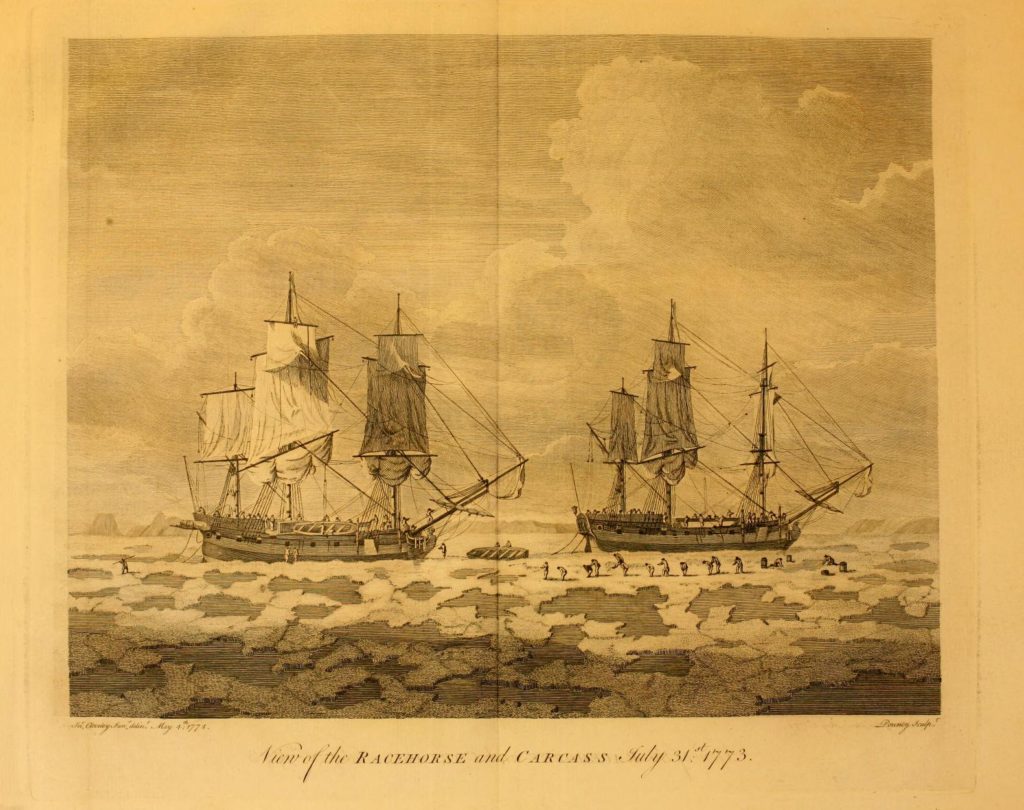By: Andrew McKendry, Nord University

Like many such expeditions, Robert Walton’s quest for the North Pole becomes most interesting when it gets derailed; fortunately for us, Walton is waylaid by the exhausted Victor Frankenstein, whose tale of horror and woe—an interruption to the anticipated account of arctic exploration—proves one of the most haunting and enduring narratives of English literature. Stopping to rescue half-crazed necromancers was, of course, never part of the original itinerary; this fateful encounter emerges from the arctic landscape itself, when the ship becomes trapped in the surrounding floe.
Last Monday (July 31st), we were nearly surrounded by ice, which closed in the ship on all sides, scarcely leaving her the sea room in which she floated. Our situation was somewhat dangerous, especially as we were compassed round by a very thick fog. We accordingly lay to, hoping that some change would take place in the atmosphere and weather. About two o’clock the mist cleared away, and we beheld, stretched out in every direction, vast and irregular plains of ice, which seemed to have no end. Some of my comrades groaned, and my own mind began to grow watchful with anxious thoughts, when a strange sight suddenly attracted our attention, and diverted our solicitude from our own situation. We perceived a low carriage, fixed on a sledge and drawn by dogs, pass on towards the north, at the distance of half a mile: a being which had the shape of a man, but apparently of gigantic stature, sat in the sledge, and guided the dogs. We watched the rapid progress of the traveller with our telescopes, until he was lost among the distant inequalities of the ice. (Shelley 1818, I.21-22)
The beginning of Walton’s story thus turns out to be the foundation for another beginning. And if we accept Shelley’s proposition (from her introduction to the 1831 edition) that every beginning “must be linked to something that went before” (9), then we must seek the beginning before even this beginning—the “something that went before” Walton’s voyage. This search is an element of the Frankenreads online exhibition that we have been developing here at Nord University, and I myself have been productively waylaid by an earlier account of artic exploration: the Honourable Constantine John Phipps’ A Voyage Towards the North Pole Undertaken By His Majesty’s Command. In the opening pages of Frankenstein, Walton ascribes his obsession with the north to the accounts of arctic travel in his uncle’s library, and Phipps’ Voyage, first published in 1774, would have been one of the most current such narratives when (by his own dating) he was a book-devouring boy. The Voyage opens, in fact, with a survey of earlier artic voyages—the very thing that fed Walton’s youthful reveries (Shelley 1818, I.5).
At first glance, Phipps’ account hardly seems like the kind of material that could inspire a poetically-inclined adventurer like Walton, let alone Shelley; the disciplined Phipps focuses his attention predominantly on climatic measurements and geographic coordinates. The attendant illustrations of the arctic orography (such as the one above) do present the forms and scale that would engender the sublimity of later depictions, but the perspective and presentation—abstracted from the landscape and reproduced from various positions—are less conducive to the awe and terror associated with the sublime. Yet at the heart of the journal we find a scene that looks strangely familiar:

Compassed round with ice, the two ships—HMS Carcass and HMS Racehorse—were nearly crushed when the floe tightened. The image of the ships immured in the ice became somewhat iconic in the ensuing decades, appearing (sometimes with variations) throughout a number of publications, such as John Payne’s 1791 Universal Geography. Though only a lexicographic accident (the word “carcass” also meaning an incendiary shell), it is hard not to hear echoes of Frankenstein in lines like “the Carcass moved, and made fast to the same field with us” (Phipps 60). Stranded for more than ten days, the Carcass was ultimately recovered in one piece; this was the end of the journey for Phipps, but was it perhaps a beginning for Shelley?
This is a mystery we will have to pursue later. Keep an eye out for our exhibition, which will be going live next month!
Works Cited
Mulgrave, Constantine John Phipps, Baron, A Voyage Towards the North Pole: Undertaken by His Majesty’s Command, 1773. London: J. Nourse, 1774.
Shelley, Mary. Frankenstein: or, The Modern Prometheus. Three volumes. London: Lackington, Hughes, Harding, Mavor, & Jones, 1818.
Shelley, Mary, Frankenstein: or, The Modern Prometheus. London: Colburn and Bentley, 1831.